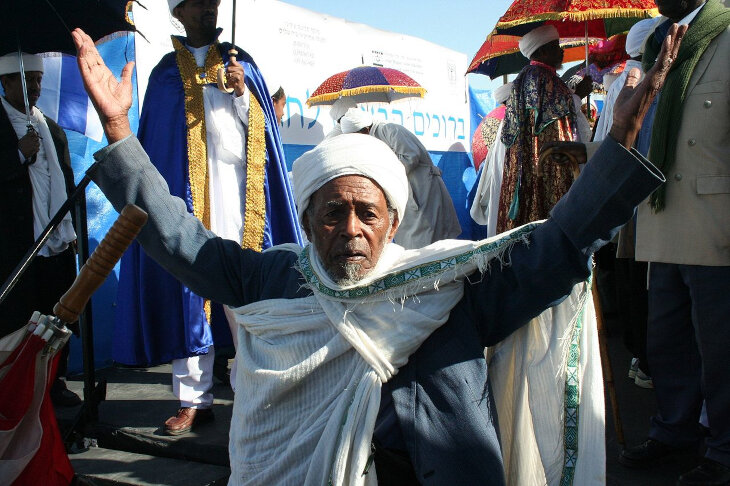 Iran’s Attack on Israel
Iran’s Attack on Israel

Jewish Geography

Jewish Geography
11 min read
A look at the history, traditions, and heroic airlift to Israel of the ancient Jewish community of Beta Israel.
Ethiopian Jews are Jewish people who, for centuries, lived in the Lake Tana region of northern Ethiopia. The community’s origins are uncertain, although travelers, scholars, and others mention them in accounts dating back to the 15th century—and possibly even as early as the ninth—while the community’s own oral history dates them back to biblical times.
Ethiopian Jews are commonly referred to as Beta Israel, which means “House of Israel” in Ge’ez—the classical Ethiopian language that Jews and Christians still use as a liturgical language—although nowadays, most Ethiopian Jews speak Amharic.
Much of the Ethiopian Jewish community was airlifted to Israel in the 1980s and 90s in response to the Ethiopian Civil War and subsequent famine. Today, Israel’s Ethiopian Jewish community numbers about 168,000,1 which includes both immigrants and their descendants.
The origins of the Beta Israel community are somewhat murky. At least some early Ethiopian Jews were Agau converts (an ancient people settled in the Ethiopian region for millennia), and others may have been merchants or traders who came over from Yemen, which, in the first centuries CE, had a sizable—albeit belligerent2—Jewish population.
 Synagogue in the village of Wolleka in Ethiopia. (Wiki, Marc Barronet)
Synagogue in the village of Wolleka in Ethiopia. (Wiki, Marc Barronet)
Some Ethiopian Jews claim their community descends from the Tribe of Dan, one of the 10 lost tribes of Israel. In the ninth century, Eldad HaDani (Eldad the Danite), an itinerant traveler, merchant, and philologist, visited much of that era’s Jewish world; claimed that he was from Kush (Ethiopia); that he was from the Tribe of Dan; and caused a sensation with his tales of the lost tribes.3 Eldad’s claims are sometimes brought as proof of the Ethiopian community’s Israelite lineage, although Eldad only spoke Hebrew—or rather his own, particular Hebrew dialect—which wasn’t a language Ethiopian Jews spoke. A number of other traditions linking the Beta Israel to the Tribe of Dan exist as well.
Some prominent rabbinical figures also link the Ethiopian Jews to the Tribe of Dan, including the 15th century, Italian-born, Rabbi Ovadia of Bartenura—best known for his commentary on the Mishna—who, after meeting two Ethiopian Jews while traveling to Israel, wrote:
I saw two of them, they were dark-skinned … and I could not tell what they were, or whether they observed the Karaite law … They said they were related to the tribe of Dan. They said that most of the pepper and the spices that the Cushites sell come from their land. I saw this with my own eyes and heard it with my own ears. However, the two men did not know the holy language [well], only a tiny bit, and their Arabic was barely comprehensible to the residents of [the land of Israel].4
Rabbi David ibn Zimra, known as the Radbaz—he was the Egyptian chief rabbi for much of the early 16th century before retiring to Tzfat in northern Israel—also wrote that the Ethiopian Jews were from the Tribe of Dan, and that they were indeed Jewish, although he was unsure about their level of Jewish observance.5
 Minister of Education Yitzhak Navon visiting kindergarten class of Ethiopian immigrants, 1985 (Israel Government Press Office)
Minister of Education Yitzhak Navon visiting kindergarten class of Ethiopian immigrants, 1985 (Israel Government Press Office)
According to the 14th century Ethiopian national epic, Kebra Nagast (the Glory of the Kings), the biblical King Solomon fathered a son, Menelik I, with the Queen of Sheba of Kush. Menelik I later returned to Ethiopia. The Ethiopian Christian Zagwe dynasty, which first came to power in 1270, claimed to be descended from that line. They held power until 1974 when Haile Selassie, the final Ethiopian king, was overthrown in a coup.
At first, the Beta Israel lived in small, somewhat independent, villages throughout parts of Ethiopia, but became more unified following the conversion of the ruling Aksum kingdom to Christianity in the fourth century. Over the centuries, mainly due to anti-Jewish persecution, the community coalesced, and developed its shared, common identity.
The Ethiopian Bible is called the Orit—a name that may derive from the Aramaic term, Orayta (אורייתא)—and is an eight volume work (called an “Octateuch”) that includes the five books of Moses, Joshua, Judges, and Ruth. Other works include a book of Psalms (Dawit), a book that contains some of Jeremiah’s prophecies, and others that aren’t as well known to the rest of the Jewish world.
Beta Israel do not follow the Talmud, although they do observe many Jewish holidays, customs, and laws including the Sabbath, circumcision, some kosher laws, ritual purity, fasts, festivals—including holidays unique to them—and offer a sacrifice the day before Passover.
 The Beta Israel village of Balankab, from H. A. Stern, Wanderings Among the Falashas in Abyssinia, 1862 (Wiki)
The Beta Israel village of Balankab, from H. A. Stern, Wanderings Among the Falashas in Abyssinia, 1862 (Wiki)
The term falasha, which means “stranger” or “outsider,” is a pejorative, and was first applied to the Jewish community in the 15th century following their revolt, which was suppressed, against the Christian ruler, Yeshaq I. Beta Israel do not use this term in relation to themselves and it is considered offensive.
As mentioned above, Beta Israel are mentioned in the written accounts of other diaspora Jews dating back to at least the 15th century, and possibly even earlier. They first gained the attention of the outside world in the 17th century, as European Christian missionaries brought back tales of the “Black Jews” they encountered in Ethiopia.
The community’s situation was dire, and suffered the consequences and ravages of war, drought, disease, and wanton persecution. In 1904, the Zionist and activist, Jacques Faitlovitch, who studied Ethiopian languages at the Sorbonne in Paris (under Joseph Halévy, also an advocate for Beta Israel), took up their cause, opened a school in 1923 in Addis Ababa, and raised tens of thousands of dollars to help with various needs. In 1912, the Chief Ashkenazi Rabbi of Israel, Rabbi Avraham Yitzchak Kook, wrote a letter expressing his sincere support for sending teachers to Ethiopia to educate the community.6
Following the fascist Italian occupation of Ethiopia, and Emperor Haile Selassie’s return from exile in 1941, the Beta Israel—despite their poverty and dwindling numbers—tried to intervene, and help European Jewry escape the Holocaust. They had limited success, and with Selassie’s assistance, 1,500 Greek refugees, among them Greek Jews, made their way to Ethiopia in 1943.7
With the outbreak of the Ethiopian Civil War in 1974 and the subsequent communist regime, the fate of Beta Israel looked bleak. As the war dragged on, and unrest and famine plagued the region, many Jews fled to neighboring Sudan.
 Ethiopian Jews who arrived on Operation Moses
Ethiopian Jews who arrived on Operation Moses
Between 1984 and 1991, about 23,000 Ethiopian Jews were airlifted to Israel on three separate missions: Operation Moses (1984-85), Operation Joshua (1985), and Operation Solomon (1991).
Operation Moses was a covert evacuation of Ethiopian Jews from Sudan to Israel by way of Brussels. Between late 1984 and early 1985, 8,000 Jews were flown—about 200 at a time—out of Sudan on commercial flights in order to avoid suspicion. The operation came to an abrupt end on January 5, 1985, when Israeli Prime Minister Shimon Peres mentioned it at a press conference, and the Sudanese government pulled the plug almost immediately afterwards. About 1,000 people were left behind, about 500 of whom were evacuated later that year as a part of Operation Joshua.
 Ethiopian Jews on a plane en route to Israel, Operation Solomon, May 1991
Ethiopian Jews on a plane en route to Israel, Operation Solomon, May 1991
(Photo: Government Press Office)
In 1991, over a period of about 36 hours, 14,325 Ethiopian Jews were airlifted from Ethiopia to Israel via Operation Solomon. The evacuees were flown on 747s and other Israeli aircraft, with one flight carrying over 1,000 people and setting the world record for the most passengers on a single flight. Two children were born en route during Operation Solomon, and most people fled Ethiopia with nothing but their cooking utensils and the clothes on their back.
With the State of Israel’s founding in 1948, Ethiopian Jews were not initially recognized as “Jews,” or granted automatic citizenship under Israel’s Law of Return. That situation remained unchanged until 1973, when Israel’s Chief Sephardi Rabbi, Rabbi Ovadia Yosef, stated:
I have come to the conclusion that Falashas are Jews who must be saved from absorption and assimilation. We are obliged to speed up their immigration to Israel and educate them in the spirit of the holy Torah, making them partners in the building of the Holy Land.8
In 1975, Israel’s Chief Ashkenazi Rabbi, Rabbi Shlomo Goren, followed suit, and stated: “You are our brothers, you are our blood and our flesh. You are true Jews.”9 Beta Israel were officially recognized under Israel’s Law of Return later that year.

Absorption of the Ethiopian community into Israel wasn’t without its hurdles, including controversy over what Rabbi Yosef called, “an act of renewing their covenant with the Jewish people;” language and cultural hurdles; and other issues common to new arrivals, including some incidents of racism.
According to the Ethiopian national epic, Kebra Nagast (the Glory of the Kings), King Solomon fathered a son, Menelik I, with the Queen of Sheba. Menelik later went to visit his father, and on his return journey was accompanied by the firstborn sons of some Israelite nobles, who, unbeknown to Menelik, stole the ark and carried it with them to Ethiopia. When Menelik learned of the theft, he reasoned that since the ark's frightful powers hadn't destroyed his retinue, it must be God's will that it remain with him.10
According to some, the ark is hidden within the belly of the Church of Our Lady Mary of Zion, in Aksum, Ethiopia. However, during World War II, Edward Ullendorff—who at the time was an officer in the British army, and already a scholar of Ethiopian history and language—claims to have muscled his way into the church past the guards, and found a model of an ark that was typical of the type of arks found in many Ethiopian churches. According to reports, “it wasn’t ancient, and certainly not the original.”11
A number of other theories link the Ark to Ethiopia as well, although none of them seem to stand up under academic scrutiny. According to Jewish tradition, the Ark was hidden away near the end of the First Temple period (422 BCE), and could be in a number of different places including buried deep beneath the Temple Mount in Jerusalem, or possibly in a cave on Mount Nebo, in present-day Jordan.
Sigd is celebrated 50 days after Yom Kippur. It is a day of fasting, praying, and then feasting. The name comes from the Aramaic word, sged, which means “prostration,” and similar to the Yom Kippur services, celebrants prostrate on the ground during Sigd prayers as well. The point of the holiday is to affirm the Ethiopian community’s connection to the holy city of Jerusalem.

A Kes celebrating the holiday of Sigd in Jerusalem (Wiki)
Kessim are Ethiopian religious leaders (priests, or cohanim). Traditionally, they were the only members of the community with a deep understanding of Beta Israel beliefs and traditions.

I want to know seriously why we have left the remnant of the Jewish Ethiopians community back in Ethiopia knowing their horrendous living conditions? I'm really upset with the stupidity of the Israel government for bringing in non-Jewish Ukrainians that further dilutes the Jewish populace of Israel. Its bad enough that there is over 70% of intermarriage in the world. Jewish Ethiopians must be offered a full education so that they can integrate into Israel's Jewish community. I prefer to see an Ethiopian Jew driving an Egged bus instead of a rude arab driving it. Members of Knesset need to have their compasses demagnetized and have them set to Ethiopia to bring the remnant of the Ethiopians to Israel. BRING OUR JEWS HOME!!!!!